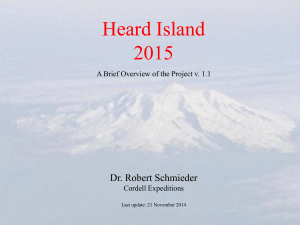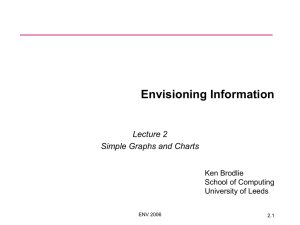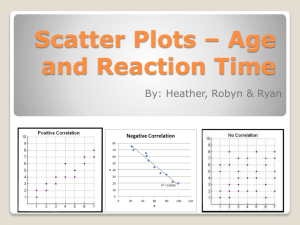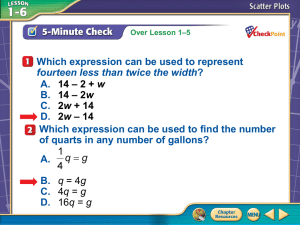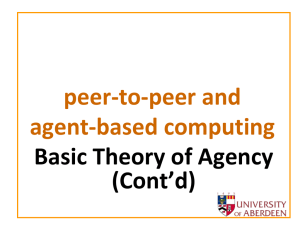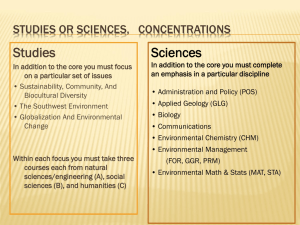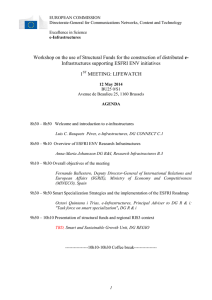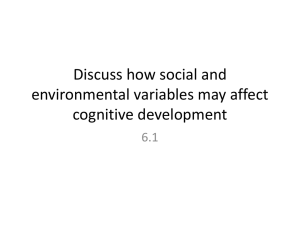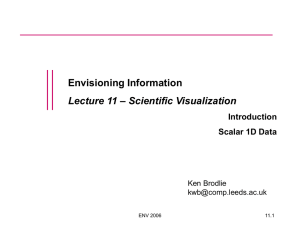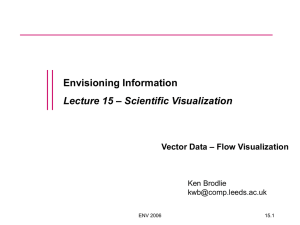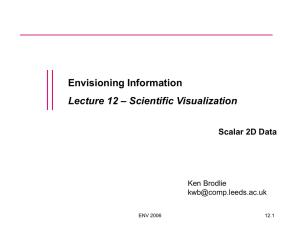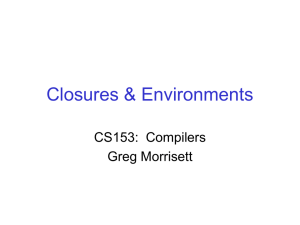part 1- scatter plots and parallel coordinates
advertisement
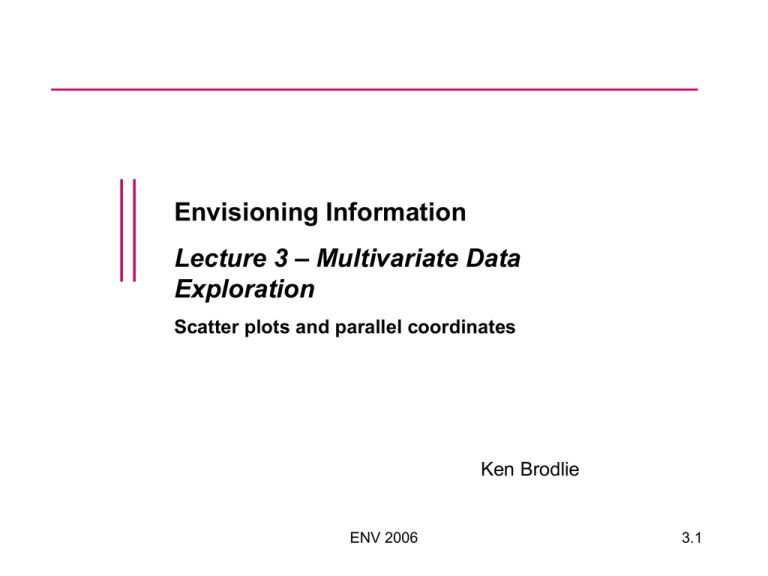
Envisioning Information Lecture 3 – Multivariate Data Exploration Scatter plots and parallel coordinates Ken Brodlie ENV 2006 3.1 Data Tables • Multivariate datasets can be expressed as a data table – Each entry in table is an observation – An observation consists of values of a set of variables, or variates • variables Exercise – Create a data table from the MSc class… observations ENV 2006 A B C 1 .. .. .. 2 .. .. .. 3.2 Scatter Plot • • For two variates, we have already met the scatter plot technique It is useful for showing what happens to one variable as another changes… ENV 2006 3.3 Scatter Plot • • • • Visicube from Datamology is a useful free charting tool Here is an example scatter plot, visualizing the speed of the (receding) galaxy NGC7531 relative to the earth, measurements of speed being taken at different points on galaxy Circles represent measurements at 133o to horizon; pluses at 43o What can you observe? http://www.datamology.com/sample-S2.shtml ENV 2006 3.4 3D Scatter Plot • Visicube has a tool specifically for 3D scatter plots • Third variate expressed as a vertical axis and widget lets you take slices at different heights • Here we have same dataset but X and Y are positions, and Z axis is velocity … ie layered by velocity – here 3rd layer (1482 – 1519 km/sec) • Observations less than 1500 km/sec highlighted in yellow (almost allowing 4D) • Conclusion? http://www.datamology.com/sample-S3.shtml ENV 2006 3.5 3D Scatter Plots XRT/3d • Here is an alternative approach, using 3D plotting… • … does this work? ENV 2006 http://www.ist.co.uk/XRT/xrt3d.html 3.6 Extending to Higher Numbers of Variables • • Additional variables can be visualized by colour and shape coding IRIS Explorer ( a scientific visualization system!) used to visualize data from BMW – – • Five variables displayed using spatial arrangement for three, colour and object type for others Notice the clusters… But there are clearly limits to how much this will scale Kraus & Ertl, U Stuttgart http://wscg.zcu.cz/wscg2001/Papers_2001/R54.pdf ENV 2006 3.7 Multivariate Visualization Techniques • Software: – Xmdvtool Matthew Ward Techniques designed for any number of variables – Scatter plot matrices – Parallel co-ordinates – Glyph techniques http://davis.wpi.edu/~xmdv Acknowledgement: Many of images in following slides taken from Ward’s work ENV 2006 3.8 What are these? ENV 2006 3.9 Multivariate Visualization • Example of iris data set – 150 observations of 4 variables (length, width of petal and sepal) – Check wikipedia for explanations of petals & sepals – Techniques aim to display relationships between variables – the analytical task Challenge in visualization is to design the visualization to match the analytical task ENV 2006 3.10 Scatter Plot Matrices ENV 2006 3.11 Scatter Plot Matrices • For table data of M variables, we can look at pairs in 2D scatter plots • The pairs can be juxtaposed: C . B . A . . . . . A . . . . . . B . . . . With luck, you may spot correlations between pairs as linear structures… or you may observe clusters . C ENV 2006 3.12 Scatter Plot Matrix – Iris Data Set ENV 2006 3.13 Scatter Plot Matrix – Car Data Set Data represents 7 aspects of cars: what relationships can we notice? For example, what correlates with high MPG? ENV 2006 3.14 Parallel Coordinates A B C D E F - create M equidistant vertical axes, each corresponding to a variable - each axis scaled to [min, max] range of the variable - each observation corresponds to a line drawn through point on each axis corresponding to value of the variable ENV 2006 3.15 Parallel Coordinates A B C D E F - correlations may start to appear as the observations are plotted on the chart - here there appears to be negative correlation between values of A and B for example - this has been used for applications with thousands of data items ENV 2006 3.16 Parallel Coordinates – Iris Data ENV 2006 3.17 Parallel Coordinates Example Detroit homicide data 7 variables 13 observations 1961 -1973 ENV 2006 3.18 Parallel Coordinates • • • Concept due to Alfred Inselberg Conceived the idea as a research student in 1959… … idea gradually refined over next 40 years http://www.math.tau.ac.il/~aiisreal/ ENV 2006 3.19 Parallel Coordinates • • • • • Parallel coordinates is a clever mechanism for transforming geometry from one space to another To get a handle on the idea, consider two variables X,Y In parallel coordinates, a point (X,Y) becomes… what? A line becomes… what? • Use this space to sketch the answers… Why is the ordering of the axes important? ENV 2006 3.20 The Screen Space Problem • • All techniques, sooner or later, run out of screen space Parallel co-ordinates – Usable for up to 150 variates – Unworkable greater than 250 variates Remote sensing: 5 variates, 16,384 observations) ENV 2006 3.21 Brushing as a Solution • • Brushing selects a restricted range of one or more variables Selection then highlighted ENV 2006 3.22 Scatter Plot Use of a ‘brushing’ tool can highlight subsets of data ..now we can see what correlates with high MPG ENV 2006 3.23 Parallel Coordinates Brushing picks out the high MPG data Can you observe the same relations as with scatter plots? More or less easy? ENV 2006 3.24 Parallel Coordinates Here we highlight high MPG and not 4 cylinders ENV 2006 3.25
